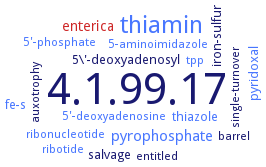4.1.99.17: phosphomethylpyrimidine synthase
This is an abbreviated version!
For detailed information about phosphomethylpyrimidine synthase, go to the full flat file.

Word Map on EC 4.1.99.17 
-
4.1.99.17
-
thiamin
-
pyrophosphate
-
enterica
-
5\'-deoxyadenosyl
-
thiazole
-
iron-sulfur
-
salvage
-
fe-s
-
pyridoxal
-
5'-phosphate
-
ribotide
-
barrel
-
auxotrophy
-
ribonucleotide
-
5'-deoxyadenosine
-
single-turnover
-
entitled
-
5-aminoimidazole
-
tpp
- 4.1.99.17
- thiamin
- pyrophosphate
- enterica
-
5\'-deoxyadenosyl
- thiazole
-
iron-sulfur
-
salvage
- fe-s
- pyridoxal
- 5'-phosphate
- ribotide
-
barrel
-
auxotrophy
- ribonucleotide
- 5'-deoxyadenosine
-
single-turnover
-
entitled
- 5-aminoimidazole
- tpp
Reaction
Synonyms
2-methyl-4-amino-5-hydroxymethylpyrimidine phosphate synthase, 4-amino-5-hydroxymethyl-2-methylpyrimidine phosphate synthase, AtTHIC, HMP phosphate synthase, HMP-P synthase, LeThiC, Thi5p, thiC
ECTree
Advanced search results
Expression
Expression on EC 4.1.99.17 - phosphomethylpyrimidine synthase
Please wait a moment until all data is loaded. This message will disappear when all data is loaded.
downregulation of AtTHIC expression by T-DNA insertion at its promoter region results in a drastic reduction of thiamine content in plants and the knock-down mutant thic1 shows albino (white leaves) and lethal phenotypes under the normal culture conditions
expression of LeThiC is tightly regulated at the transcriptional and posttranscriptional level by multiple factors, such as light, Fe2+ status and thiamine diphosphate-riboswitch. A feedback regulation mechanism is involved in synthesis of the pyrimidine moiety for controlling thiamine synthesis in tomato
the expression intensity of LeThic at both the transcriptional (S form mRNA) and protein levels is increased under Fe2+ deficiency (1 or 0 mM Fe2+) compared with Fe2+ sufficiency (10 and 100 mM Fe2+), whereas no effects on LeThiC expression are observed under deficiency of Zn2+ or Mn2+
the THIC gene is negatively regulated by thiamin itself, regulation by conserved regions of mRNA that bind specific metabolites (riboswitches). As the thiamine riboswitch only responds to thiamin diphosphate but not thiamine, the down-regulation of THIC mRNA implies that the externally provided thiamine is converted to thiamine diphosphate inside the cell leading to the conformational change inducing mRNA instability
the transcript level in seedlings grown in 24 h of light is substantially higher than that in seedlings exposed to a single long day cycle (16-h light/8-h dark)
THIC transcript is not detectable two days after germination, but is readily detectable at day five
transcription factor ThiR, that harbors an N-terminal helix-turn-helix (HTH) DNA binding domain and C-terminal ThiN (TMP synthase) domain, represses the expression of thiC in presence of thiamine by a DNA operator sequence that is conserved across archaeal phyla. Despite having a ThiN domain, ThiR is catalytically inactive in compensating for the loss of ThiE (TMP synthase) function. ThiR homologs are widespread in archaea, suggesting that the regulation of these thiamine biosynthesis genes is governed by a repressor protein and not by a riboswitch or activation mechanism
the THIC gene is negatively regulated by thiamin itself, regulation by conserved regions of mRNA that bind specific metabolites (riboswitches). As the thiamine riboswitch only responds to thiamin diphosphate but not thiamine, the down-regulation of THIC mRNA implies that the externally provided thiamine is converted to thiamine diphosphate inside the cell leading to the conformational change inducing mRNA instability

the THIC gene is negatively regulated by thiamin itself, regulation by conserved regions of mRNA that bind specific metabolites (riboswitches). As the thiamine riboswitch only responds to thiamin diphosphate but not thiamine, the down-regulation of THIC mRNA implies that the externally provided thiamine is converted to thiamine diphosphate inside the cell leading to the conformational change inducing mRNA instability
-
-
the transcript level in seedlings grown in 24 h of light is substantially higher than that in seedlings exposed to a single long day cycle (16-h light/8-h dark)
-
-
THIC transcript is not detectable two days after germination, but is readily detectable at day five
-
-
transcription factor ThiR, that harbors an N-terminal helix-turn-helix (HTH) DNA binding domain and C-terminal ThiN (TMP synthase) domain, represses the expression of thiC in presence of thiamine by a DNA operator sequence that is conserved across archaeal phyla. Despite having a ThiN domain, ThiR is catalytically inactive in compensating for the loss of ThiE (TMP synthase) function. ThiR homologs are widespread in archaea, suggesting that the regulation of these thiamine biosynthesis genes is governed by a repressor protein and not by a riboswitch or activation mechanism

transcription factor ThiR, that harbors an N-terminal helix-turn-helix (HTH) DNA binding domain and C-terminal ThiN (TMP synthase) domain, represses the expression of thiC in presence of thiamine by a DNA operator sequence that is conserved across archaeal phyla. Despite having a ThiN domain, ThiR is catalytically inactive in compensating for the loss of ThiE (TMP synthase) function. ThiR homologs are widespread in archaea, suggesting that the regulation of these thiamine biosynthesis genes is governed by a repressor protein and not by a riboswitch or activation mechanism
-
-


 results (
results ( results (
results ( top
top





